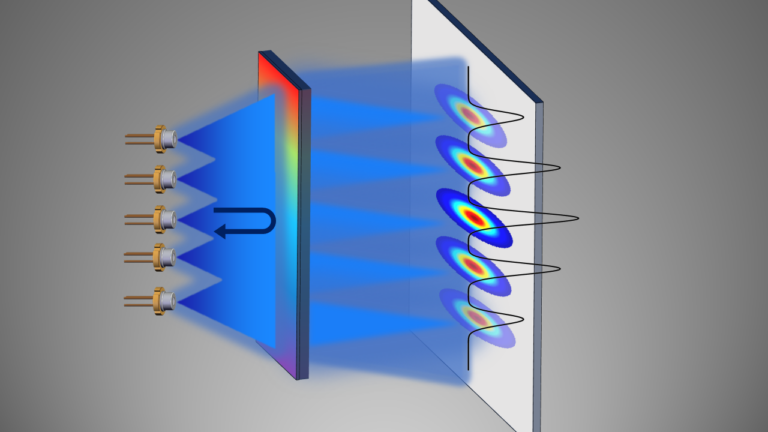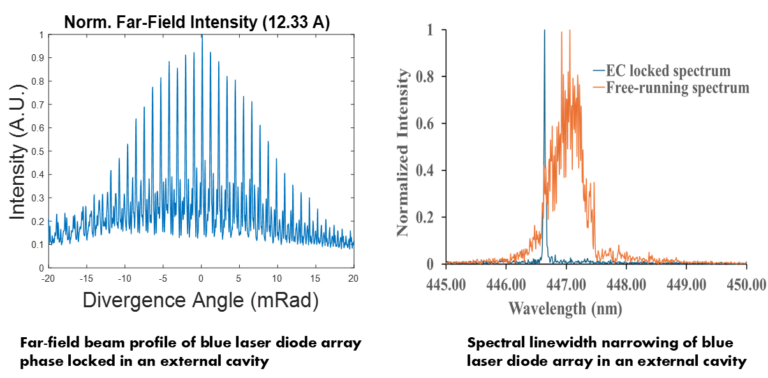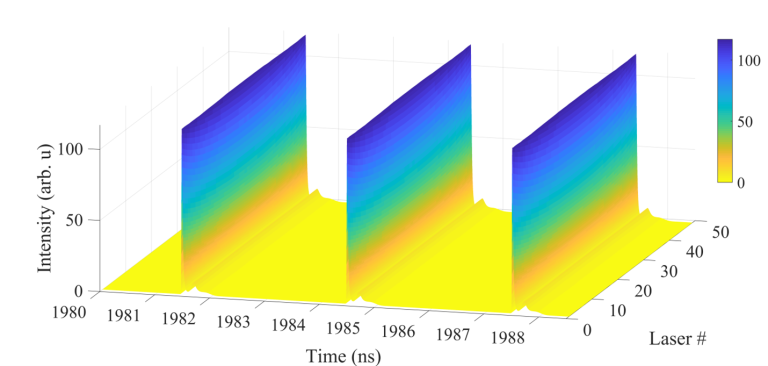
Semiconductor laser diodes are employed for a wide variety of applications. Such lasers can emit light in a wide range of wavelengths, exhibit high (in the range of 60-70%) electro-optical efficiency, are compact, and are low cost. However, a single diode’s emission power is in the range of Watts or lower. Our goal is to increase the capacity of such lasers by phase locking and synchronizing them in scalable arrays. By beam combining many diodes, we aim to provide high-emission radiance [1,2].
Near IR
One of the approaches to increase the functionality of semiconductor lasers has been the use of master oscillator power amplifier (MOPA). Such designs have been shown to allow for almost perfect semiconductor diode phase locking with arrays as large as 900 lasers [3–5]. The main challenges though are scalability to large power and engineering complexity. External cavity designs are very attractive since phase-locking is spontaneous and consequently engineering complexity to achieve phase-locking is much lower than for MOPA designs. While excellent beam quality from single mode and broad-area diode arrays has been demonstrated [6–11], the scalability to very large arrays and stacked-arrays remains an open matter. Accordingly, we are developing experimental designs to enable robust phase locking of large numbers of diodes in an array and have successfully demonstrated phase-locking of 1-D arrays very close to the diffraction limit in the near-infrared (NIR) optical regime [7]. Our experimental efforts are being supported and guided by computational simulations: we have developed codes to numerically simulate very large (O (100,000)) 1-D and 2-D diode arrays. Our external cavity design approach is supplemented by measurements aimed at optimizing the phase-locking system. These measurements include simultaneous measurements of the time series, optical spectrum, far-field beam profile and beam quality factor, and others. Beam-combined high-power lasers emitting with excellent beam qualities are ideal sources for several applications including directed energy.
Blue Diodes
High-power, narrow-linewidth, tunable blue lasers are in high demand for many applications, such as high-resolution spectroscopy, holographic data storage, laser cooling, ultraviolet light generation, and underwater applications. For many applications, a single laser does not provide sufficient power, consequently, beam combining of multiple lasers is necessary. In our lab, we are designing and building high-power, high-quality blue laser systems via coherent beam combing and phase locking of broad-area blue laser diode arrays. Since blue diode arrays have only recently become commercially available and accumulated knowledge and experience with blue diodes are limited, beam combining of blue diode arrays is challenging. Consequently, high-power light sources in the blue spectral region are still deficient in beam quality. We are developing several optical setups involving blue laser arrays. One example is a V-shaped external Talbot cavity to couple the laser diodes and induce phase synchrony. We have recently demonstrated very narrow (O (10-15 pm)) linewidth emitted from broad-area blue diode array [12]. The motivation of our work is to design and demonstrate the emission of a high-power blue laser with excellent beam quality. These high-power blue lasers will be a great source for several industrial applications and for underwater sensing and communication.

Pulsed Lasers
Controllable pulsing in diode lasers has been in the spotlight in recent years. A variety of pulsing mechanisms have been explored, including mode-locking, gain-switching, Q-switching, and others. In our lab, we are studying phase-locking of pulsed lasers in arrays as well as mode-locking in multimode diode lasers. Several years ago, we computationally demonstrated the feasibility of phase-locking a 49-diode array [13]. We are now expanding these studies to 2-D homogeneous and heterogeneous arrays, along with the effects of modulating current amplitude and frequency on phase-locking.
Fig. 1: Evolution of the beam size of a single emitter in the array with the propagation distance around the near field focus. This measurement is of interest to derive the beam quality factor M² that impacts the total width of the combined coherent beams from multiple emitters.

Fig. 2: Synchronized pulsing behavior in a 1D-array of 49 lasers subject to optical feedback, global coupling, and periodic modulation of the bias current.
Works Cited
- T. Y. Fan, “Laser beam combining for high-power, high-radiance sources,” IEEE J. Sel. Top. Quantum Electron. 11(3), 567–577 (2005).
- A. M. Jones and J. T. Gopinath, “Fast-to-slow axis mode imaging for brightness enhancement of a broad-area laser diode array,” Opt. Express 21(15), 17912–17919 (2013).
- R. K. Huang, L. J. Missaggia, J. P. Donnelly, C. T. Harris, and G. W. Turner, “High-brightness slab-coupled optical waveguide laser arrays,” IEEE Photonics Technol. Lett. 17(5), 959–961 (2005).
- K. J. Creedon, S. M. Redmond, G. M. Smith, L. J. Missaggia, M. K. Connors, J. E. Kansky, T. Y. Fan, G. W. Turner, and A. Sanchez-Rubio, “High efficiency coherent beam combining of semiconductor optical amplifiers,” Opt. Lett. 37(23), 5006–5008 (2012).
- J. L. Levy and K. Roh, “Coherent array of 900 semiconductor laser amplifiers,” in Photonics West ’95, 2382, pp. 58–69. (1995)
- B. Liu, Y. Liu, and Y. Braiman, “Coherent beam combining of high-power broad-area laser diode array with a closed-V-shape external Talbot cavity,” Opt. Express 18(7), 7361–7368 (2010).
- B. Liu and Y. Braiman, “Coherent beam combining of high-power broad-area laser diode array with near diffraction limited beam quality and high power conversion efficiency,” Opt. Express 21(25), 31218–31228 (2013).
- C. J. Corcoran and F. Durville, “Passive coherent combination of a diode laser array with 35 elements,” Opt. Express 22(7), 8420–8425 (2014).
- K. Hirosawa, F. Shohda, T. Yanagisawa, and F. Kannari, “In-phase synchronization of array laser using intra- Talbot-cavity second harmonic generation,” Proc. SPIE 9342, 934216 (2015).
- D. Mehuys, K. Mitsunaga, L. Eng, W. K. Marshall, and A. Yariv, “Supermode control in diffraction-coupled semiconductor laser arrays,” Appl. Phys. Lett. 53(13), 1165–1167 (1988).
- J. R. Leger and G. Mowry, “External diode-laser-array cavity with mode-selecting mirror,” Appl. Phys. Lett. 63(21), 2884–2886 (1993).
- P. R. Nyaupane, P. L. Likamwa, and Y. Braiman, Spectral Linewidth Narrowing of Broad-Area Blue Diode Bar in V-Shape External Talbot Cavity, Optics Letters 47, 2802 (2022).
- Liu, Y. Braiman, N. Nair, Y. Lu, Y. Guo, P. Colet, and M. Wardlaw, “Nonlinear Dynamics and Synchronization of an Array of Single Mode Laser Diodes in External Cavity Subject to Current Modulation”, Optics Communications 324, 301 (2014).
Related Works